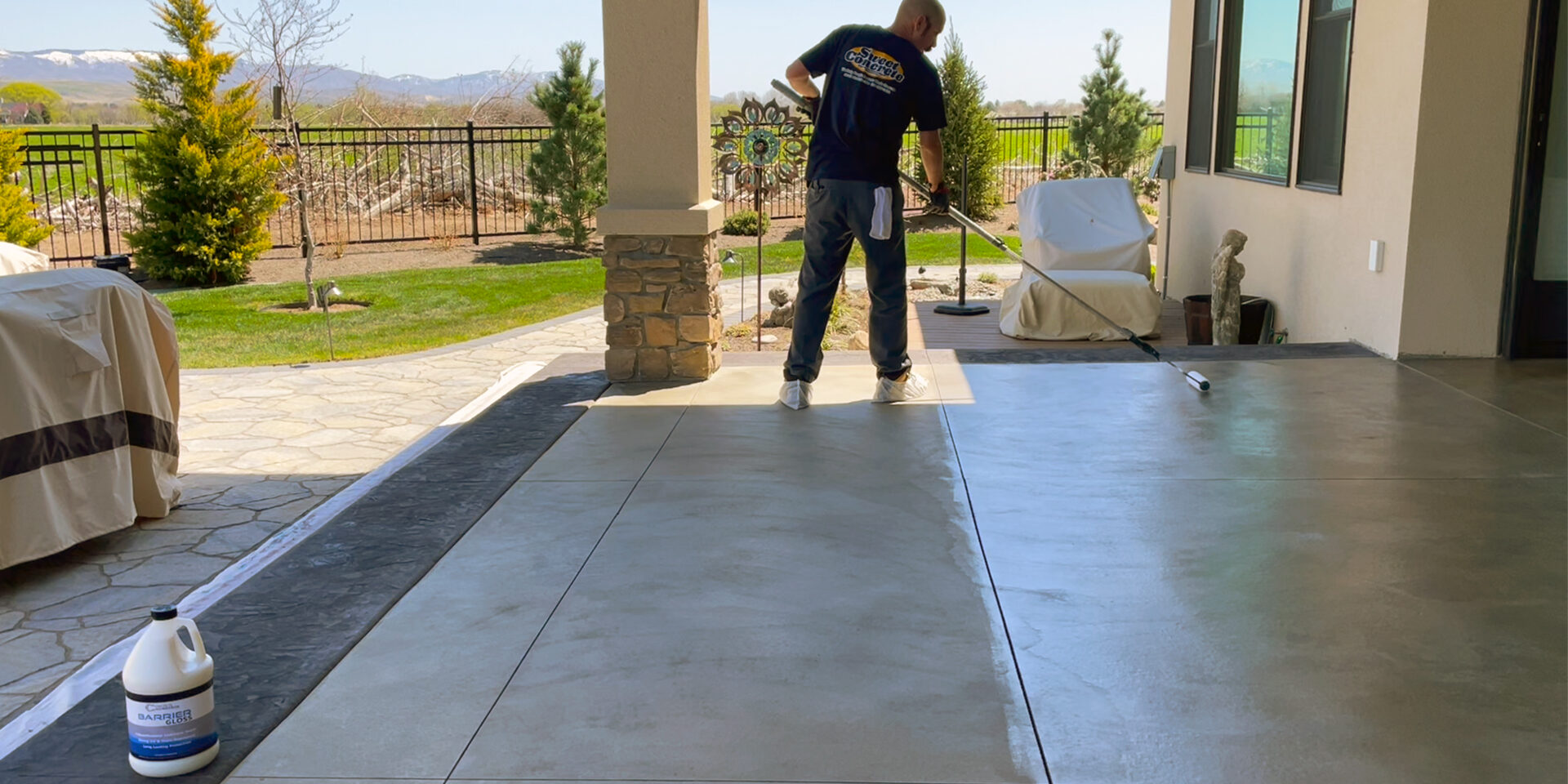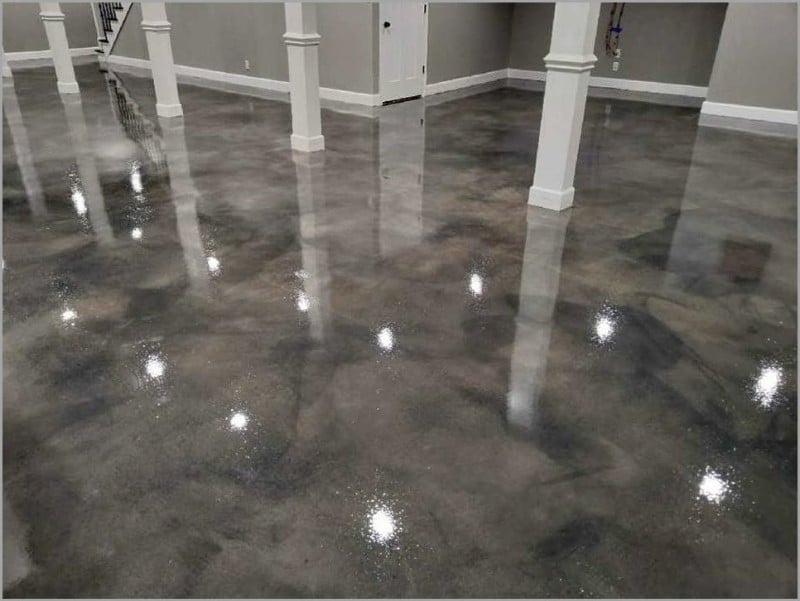Steps for selecting the right stained concrete company in near you
All About Stained Concrete: A Comprehensive Overview to Its Benefits and Applications
Stained concrete has become a prominent selection for both residential and commercial spaces. Its ability to combine visual allure with usefulness makes it an intriguing choice. Various discoloration strategies supply a variety of colors and finishes, enabling personalization. The advantages prolong beyond appearance. Comprehending its applications and maintenance demands is essential for anybody considering this flexible material. The subtleties of stained concrete invite additionally expedition.
What Is Stained Concrete?

Discoloration can be related to numerous surfaces, consisting of floorings, driveways, and patios, making it a versatile alternative for both interior and outside areas. The treatment can accomplish an array of looks, from natural tones to vibrant, modern designs. Unlike paint, stained concrete keeps its appearance gradually, as it comes to be an integral component of the concrete itself. Generally, stained concrete acts as a reliable method for transforming common concrete into aesthetically striking surface areas.
Advantages of Stained Concrete
Stained concrete offers significant benefits, especially in aesthetic allure and durability - stained concrete company. Its vivid shades and distinct patterns boost the aesthetic appeal of any space, making it a preferred selection for both household and commercial applications. In addition, the longevity of stained concrete assurances that it stays a sensible investment gradually, withstanding wear and tear
Visual Appeal
One of the most compelling benefits of utilizing stained concrete is its remarkable visual allure. Stained concrete deals a distinct and functional appearance that can match various style styles, from modern to rustic. The mixture of vivid colors and intricate patterns permits house owners and designers to create personalized surfaces that can improve the overall setting of a space. Unlike conventional floor covering options, stained concrete can resemble the appearance of all-natural rock or polished marble, providing a high end appearance without the linked costs. Furthermore, the shiny finish choices can show light, more brightening insides. This flexibility makes stained concrete a favored choice for both property and commercial applications, where aesthetic effect is critical.
Toughness and Long life
The outstanding aesthetic qualities of stained concrete are complemented by its impressive durability and longevity - local stained concrete. Stained concrete surface areas are immune to deterioration, making them suitable for high-traffic areas both inside and outdoors. Their durable nature suggests they can withstand extreme climate condition, consisting of severe temperature levels, rainfall, and UV direct exposure, without significant deterioration. Additionally, stained concrete needs marginal upkeep contrasted to various other flooring alternatives, as it does not require constant securing or refinishing. This long life not just lowers replacement prices but likewise adds to a sustainable building approach. Overall, stained concrete provides a long-lasting remedy that combines visual appeal with useful benefits, guaranteeing its value gradually
Various Sorts Of Staining Techniques
Different staining techniques can substantially influence the aesthetic qualities of concrete surface areas. The three main methods include acid staining, which responds chemically with the concrete, water-based discoloration, which provides a broader variety of colors, and overlay staining choices that offer a fresh surface. Each method has unique qualities and applications that deal with different layout choices and task needs.
Acid Discoloration Technique
Just how can house owners transform ordinary concrete surfaces into visually striking attributes? One efficient approach is acid staining, a popular technique that boosts the natural elegance of concrete. This process includes using an option of water, hydrochloric acid, and metal salts to the concrete surface. As the acid responds with the lime existing in the concrete, it develops rich, variegated colors that appear like marble or rock. Acid staining is understood for its durability and resistance to fading, making it a long-lasting choice for both interior and outside applications. Nonetheless, it is vital to note that the outcomes can vary based on the original concrete color and structure - stained concrete company. Proper application and sealing are essential for achieving the preferred aesthetic and durability
Water-Based Staining Method
A popular alternative to acid staining, the water-based discoloration technique uses homeowners a flexible method to enhance concrete surfaces. This technique makes use of water-soluble dyes and pigments, enabling a broad array of shades and surfaces. Unlike acid spots, water-based stains can be used to unsealed concrete and supply a simpler cleanup process. The outcomes can attain a more consistent appearance and can be layered to produce special results. In addition, water-based spots are generally much less hazardous and emit fewer unpredictable natural compounds (VOCs), making them extra eco-friendly. House owners may value the ability to customize their concrete surfaces with different shades, allowing for imaginative expression while preserving longevity and durability in their floor covering options.
Overlay Staining Options
Numerous overlay discoloration choices exist for house owners looking to revitalize their concrete surfaces. One popular choice is acid discoloration, which responds chemically with the concrete to produce abundant, variegated colors. One more alternative is water-based staining, offering a broader shade combination and less complicated application. Additionally, concrete overlays can be combined with patterns for elaborate designs, boosting aesthetics. For a much more textured finish, homeowners may take into consideration utilizing stamped overlays that simulate all-natural products like rock or floor tile. Each strategy provides one-of-a-kind advantages, from durability to modification, enabling a personalized touch. Eventually, the choice of overlay discoloration depends upon the wanted appearance and the condition of the existing concrete, making sure a revitalized and appealing surface.
Applications of Stained Concrete
Stained concrete offers a functional solution for various applications, improving both visual appeal and functionality. This material is generally used in household, commercial, and commercial settings, making it a preferred selection amongst architects and developers. In homes, stained concrete can offer as fashionable flooring or outdoor patio areas, giving a sophisticated look while staying durable.
In business rooms, such as retail shops and restaurants, stained concrete adds to a modern-day setting and can hold up against heavy foot traffic. In addition, stained concrete is progressively used in public spaces like parks and walkways, where its ability to resemble natural rock or various other products adds visual passion.
Moreover, stained concrete is perfect for pool decks and driveways, offering a slip-resistant surface area that is very easy to keep. Overall, the flexibility of stained concrete makes it appropriate for countless environments, providing to varied tastes and needs.
Maintenance and Treatment for Stained Concrete
Appropriate upkeep guarantees the durability and charm of stained concrete surface areas. Normal cleansing is crucial; using a moderate cleaning agent and water with a soft-bristle brush aids get rid of dust and crud without damaging the finish. It is suggested to stay clear of extreme chemicals that can strip away the discolor or sealer.
Securing stained concrete is crucial for security against moisture, stains, and use. A high-quality sealer should be reapplied each to three years, depending upon the web traffic and exposure the surface area withstands. Furthermore, addressing spills quickly will protect against staining and staining.

Price Considerations for Stained Concrete Projects
When planning a tarnished concrete project, budget plan factors to consider play an essential duty in establishing the general price. The costs related to stained concrete can vary considerably based on numerous elements. Initially, the dimension of the area to be stained directly influences material and labor costs. Larger areas will normally need even more sources. Second, the kind of tarnish selected-- acid-based or water-based-- can affect rates, with acid stains frequently being much more expensive. In addition, the intricacy of the style, consisting of patterns or multiple colors, can boost labor prices. Preparation job, such as cleansing and grinding the concrete surface area, adds to the preliminary expenses too. The choice in between DIY installation and working with a professional contractor will further impact the spending plan. Recognizing these factors enables home owners to make informed monetary choices regarding their stained concrete jobs, guaranteeing they accomplish the preferred aesthetic within their monetary ways.
Tips for Picking the Right Stained Concrete for Your Room
Selecting the right stained concrete for a particular space involves careful consideration of various elements past simply spending plan. One should assess the intended use of the area. High-traffic areas might call for even more durable coatings, while attractive applications can prioritize appearances.
The shade palette is another essential aspect; the chosen colors should balance with existing design and lights. It's also essential to take into account the surface area structure, as smooth coatings can boost elegance, while textured alternatives might guarantee security in damp locations.
Neighborhood climate and ecological conditions play a substantial role in the durability and maintenance of stained concrete, influencing the choice of sealants and coatings.
Seeking advice from with professionals can give beneficial insights tailored to certain needs, ensuring the choice of the excellent stained concrete that aligns with both functionality and style.
Frequently Asked Questions
Can Stained Concrete Be Applied Over Existing Flooring?
Stained concrete can undoubtedly be applied over existing floor covering, supplied the surface area is secure and effectively prepared. This method permits an aesthetic upgrade without the need for full elimination of the initial flooring materials.
The Length Of Time Does Stained Concrete Last?
Stained concrete can last for years when properly kept. Variables such as traffic, environmental conditions, and application methods substantially affect its durability, with many installments remaining dynamic and undamaged for 10 to three decades.
Is Stained Concrete Slippery When Damp?
Stained concrete can be unsafe when damp, as the finish may develop a smooth surface. Nonetheless, making use of non-slip ingredients or textured surfaces can minimize this concern, enhancing safety and security without jeopardizing the visual charm of the concrete.
Can I Stain Concrete Myself, or Should I Hire an Expert?
The decision to stain concrete directly or work with a professional hinges on ability degree and task complexity. While DIY discoloration can conserve money, specialists assure ideal outcomes, especially for detailed layouts or big surface areas.
What Color styles Are Available for Stained Concrete?
The range of colors see this site available for stained concrete consists of natural tones like browns and tans, lively shades such as reds and blues, and softer colors like pastels. This palette enables innovative, tailored layout options.